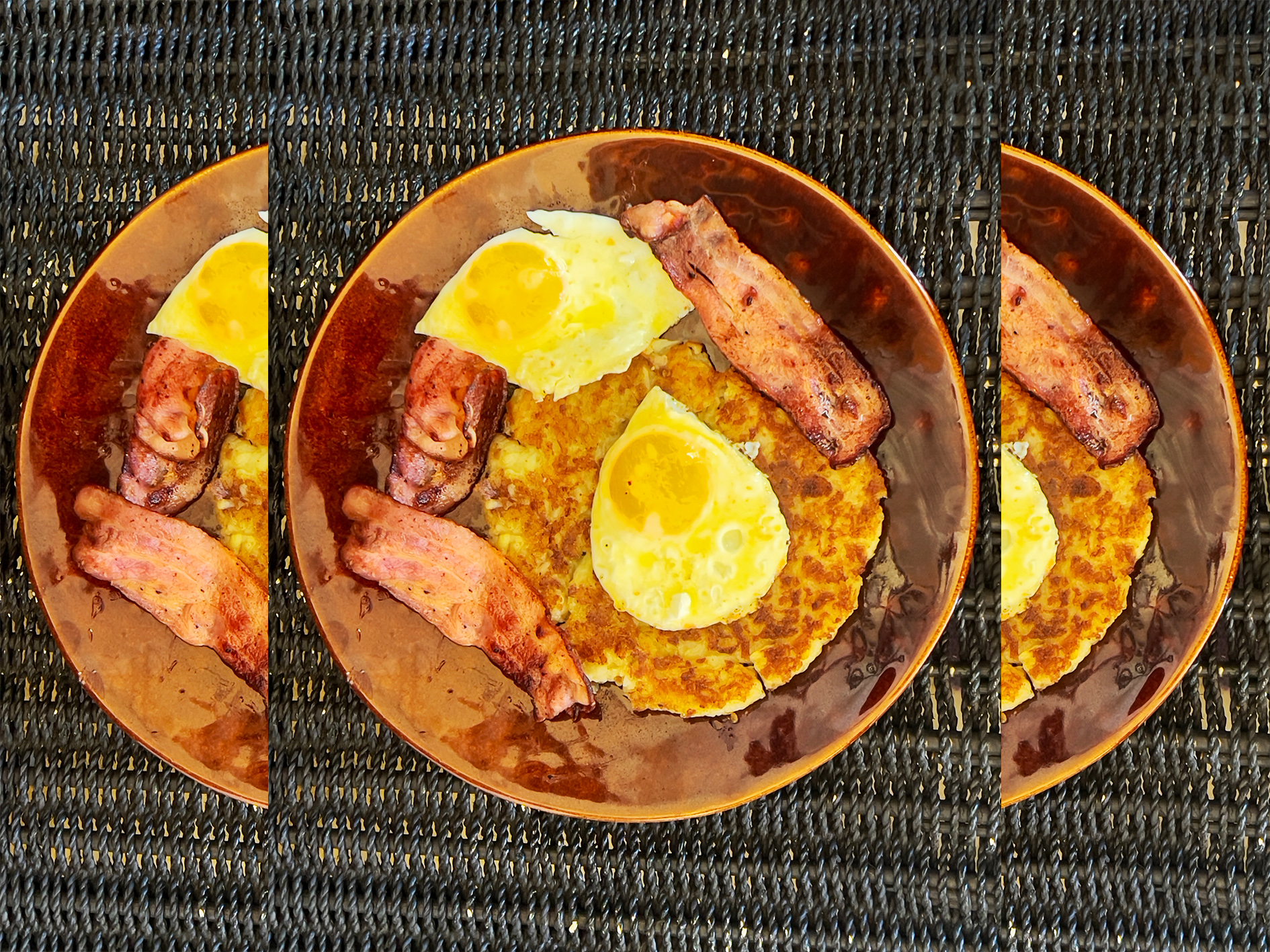Farmers in the Swiss German-speaking canton of Bern were eating fried potato pancakes called rösti for breakfast as early as the 17th century, possibly earlier. Its origins in the area surrounding Bern explain its French name of röstis bernois.
The Swiss fell in love with potatoes soon after their arrival in Europe in the 16th century, and in time the consumption of rösti spread to the other German-speaking cantons of Switzerland, on to the French and Italian speaking cantons, where the languages spoken are Swiss Italian, Swiss German, and Romansh; and ultimately the world. With 19 of the country’s 26 cantons speaking German Swiss, it’s easy to perceive why its fame spread so rapidly.
In my time, in Cape restaurants I have been served a steak on top of a crisp, round rösti, often treated as a side dish or secondary item; even as the potato offering on the plate, as though there might be a choice of baked potato, chips or rösti. But rösti began its life as a breakfast staple, given that it really set a farmer up for a hard day’s work in a chilly climate; later, it came to be served with other meals, too.
They are made either solely with potato, or with onion, or cheese (or both). They need salt and pepper, and herbs go well with them. On the breakfast plate, they can be served with bacon or ham, fried or scrambled eggs (for those, like me, who adore a runny yolk, a rösti is just the thing to go with that), or crispy fried onions. A traditional accompaniment is Fleischkäse or liver/meat cheese, which isn’t cheese at all but a loaf of finely ground pork, beef and other meats (even horse) that is baked, cooled and sliced.
But: it would be a mistake to presume that rösti is made of any kind of potato, mashed or leftover roasties, say. Not at all. They’re made either from boiled potatoes (unpeeled), or raw potato, grated, before squeezing out excess water. Whether they are boiled and chilled, or grated raw, varies from Swiss region to region. Both versions will be vehemently argued for, and against, depending on who you’re speaking to.
Enjoy Tony Jackman’s writing and way with food? Sign up to Tony’s weekly newsletter here. It’s free, and in your in-box every Friday afternoon. If it goes to promotions or spam at first, please drag it into your inbox.
I believe they are best boiled first, preferably in their jackets, in salted water, the night before you plan to cook them, and then refrigerated overnight. In the morning, peel them (just by picking the skins off carefully with your fingers) and grate them with the coarse side of the grater (the one you probably use for Cheddar cheese).
A crisp, buttery rösti is an ideal base for fried eggs and bacon. I think they’re better with onion in them, though when made purely of potato they have that pure potato charm. Perhaps, if you’re a rösti virgin, you might want to start with a plain potato one, and imagine that after eating it you’ll be off for a day of milking cows and churning butter.
(Serves 4)
Ingredients
1kg potatoes, unpeeled
1 small onion (optional)
Nutmeg
Salt
Black pepper
Ghee (clarified butter), about 3 Tbsp per rösti
Method
The evening before, boil the potatoes in their jackets, in salted water, for 15 minutes. (Parboiling traditionally takes about 10 minutes, and fully cooked potatoes 20. Cooking them for 15 makes them easier to grate while retaining their “body”, so to speak.)
Refrigerate them overnight.
In the morning, peel them and grate them into a bowl.
Add nutmeg, salt and pepper. If using an onion, grate that into a colander, squeeze out excess water over the sink, and add the onion to the potatoes.
Use a large fork to mix the potato gently, interfering as little as possible so that the potato does not disintegrate.
Divide into four. Form into balls between your palms and then pat them into flat rounds, fairly thick.
Read how to clarify butter here, or buy a tub of ghee from an Indian spice shop such as Gorima’s.
Melt 3 Tbsp of ghee in a flat, heavy pan.
Add a round of potato to the pan and leave alone to brown and firm. You should be able to see at the edges when it is browned underneath. Resist the temptation to interfere too soon.
Hold a clean wooden board over the pan, one bigger than its width. Quickly, yet carefully, tip it over 180 degrees for the rösti to fall on the board, then slide it carefully back into the pan. (While doing that, somehow get some more butter into the pan to melt, or ask somebody to do so.) Be warned that this can go flipping wrong. If necessary, reshape the potato in the pan. (Cook them often enough and you’ll soon get the hang of it.)
Serve with a fried egg (or two) on top, and bacon rashers. DM
Tony Jackman is Galliova Food Writer 2023, jointly with TGIFood columnist Anna Trapido. Order his book, foodSTUFF, here
Follow Tony Jackman on Instagram @tony_jackman_cooks.
This dish is photographed on a plate by Mervyn Gers Ceramics.




 Rösti breakfast: Breakfast rösti with fried eggs and crispy bacon. (Photo: Tony Jackman)
Rösti breakfast: Breakfast rösti with fried eggs and crispy bacon. (Photo: Tony Jackman)
